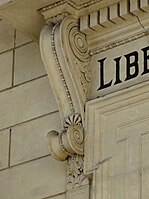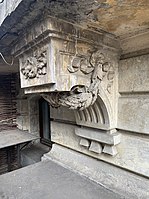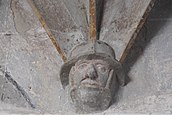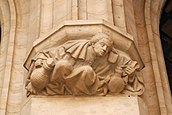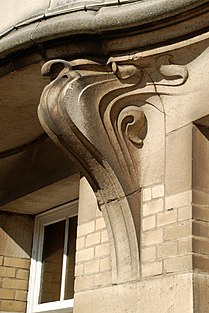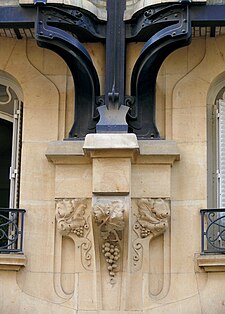Inarchitecture,acorbelis a structural piece of stone, wood or metal jutting from a wall to carry asuperincumbentweight,[1]a type ofbracket.[2]A corbel is a solid piece of material in the wall, whereas a console is a piece applied to the structure. A piece of timber projecting in the same way was called a "tassel" or a "bragger" in England.[1]
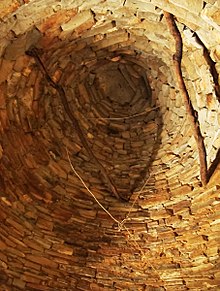
The technique ofcorbelling,where rows of corbels deeply keyed inside a wall support a projecting wall orparapet,has been used sinceNeolithic(New Stone Age) times. It is common inmedieval architectureand in theScottish baronial styleas well as in the vocabulary ofclassical architecture,such as themodillionsof aCorinthian cornice.Thecorbel archand corbel vault use the technique systematically to make openings in walls and to form ceilings. These are found in the early architecture of most cultures, fromEurasiatoPre-Columbian architecture.[note 1]
Aconsoleis more specifically an S-shaped scroll bracket in the classical tradition, with the upper or inner part larger than the lower (as in the first illustration) or outer.Keystonesare also often in the form of consoles.[3]Whereas "corbel" is rarely used outside architecture, "console" is widely used forfurniture,as inconsole table,and other decorative arts where the motif appears.
The wordcorbelcomes fromOld Frenchand derives from theLatincorbellus,adiminutiveofcorvus( "raven"), which refers to the beak-like appearance.[1][note 2]Similarly, the French refer to a bracket-corbel, usually a load-bearing internal feature, as acorbeau( "crow").
Decorated corbels
editNorman(Romanesque) corbels often have a plain appearance,[1]although they may be elaborately carved with stylised heads of humans, animals or imaginary "beasts", and sometimes with other motifs (TheChurch of St Mary and St DavidinKilpeck, Herefordshireis a notable example, with 85 of its original 91 richly carved corbels still surviving).[4]
Similarly, in theEarly English periodcorbels were sometimes elaborately carved, as atLincoln Cathedral,and sometimes more simply so.[1]
Corbels sometimes end with a point apparently growing into the wall, or forming a knot, and often are supported by angels and other figures. In the later periods the carved foliage and other ornaments used on corbels resemble those used in thecapitalsofcolumns.[1]
Throughout England, inhalf-timberwork, wooden corbels ( "tassels" or "braggers" ) abound, carrying window-sills ororiel windowsin wood, which also are often carved.[1]
Classical architecture
editThe corbels carryingbalconiesin Italy and France were sometimes of great size and richly carved, and some of the finest examples of the ItalianCinquecento(16th century) style are found in them.[1]Taking a cue from 16th-century practice, the Paris-trained designers of 19th-centuryBeaux-Arts architecturewere encouraged to show imagination in varying corbels.[citation needed]
Corbel tables
editAcorbel tableis a projecting mouldedstring coursesupported by a range of corbels. Sometimes these corbels carry a smallarcadeunder the string course, the arches of which are pointed and trefoiled. As a rule, the corbel table carries thegutter,but inLombard workthe arcaded corbel table was used as a decoration to subdivide the storeys and break up the wall surface. In Italy sometimes over the corbels will form a moulding, and above a plain piece of projecting wall forming aparapet.[1]
The corbels carrying the arches of the corbel tables in Italy and France were often elaborately moulded, sometimes in two or three courses projecting over one another; those carrying themachicolationsof English and French castles had four courses.[1]
In modernchimneyconstruction, a corbel table is constructed on the inside of afluein the form of a concrete ring beam supported by a range of corbels. The corbels can be eitherin-situor pre-cast concrete. The corbel tables described here are built at approximately ten-metre intervals to ensure stability of thebarrelofrefractorybricks constructed thereon.[citation needed]
Corbelling
editCorbelling, where rows of corbels gradually build a wall out from the vertical, has long been used as a simple kind ofvaulting,for example in many Neolithicchambered cairns,where walls are gradually corbelled in until the opening can be spanned by a slab.
Corbelled vaults are very common in early architecture around the world. Different types may be called thebeehive house(ancient Britain and elsewhere), the Irishclochán,the pre-RomannuragheofSardinia,and thetholos tombs(or "beehive tombs" ) of LateBronze Age Greeceand other parts of the Mediterranean.[citation needed]
Inmedieval architecture,the technique was used to support upper storeys or a parapet projecting forward from the wall plane, often to formmachicolations(openings between corbels could be used to drop things onto attackers). This later became a decorative feature, without the openings. Corbelling supporting upper stories and particularly supporting projecting cornerturretssubsequently became a characteristic of theScottish baronial style.
Medieval timber-framed buildings often employjettying,where upper stories arecantileveredout on projecting wooden beams in a similar manner to corbelling.
Gallery
edit- Short visual history of corbels
-
Renaissancecorbels of theSanta Maria della Pace(Rome)
-
Rocococorbel with a mascaron, on theHôtel Jeanne d'Albret(Paris)
-
Gothic Revivalcorbel supported balcony inPotsdam(Germany)
-
19th centuryEclectic Classicistcorbels on Rue des Saints-Pères (Paris)
See also
editNotes
edit- ^See for example,Maes Howe,a particularly fine Neolithic chambered cairn in Scotland.
- ^Oxford English Dictionarygives a similar etymology but from Latin corvellum or corvellus.
References
editCitations
edit- ^abcdefghijChisholm 1911.
- ^Oxford English Dictionary Second Edition on CD-ROM (v. 4.0). Oxford University Press, 2009.
- ^Summerson, John,The Classical Language of Architecture,p. 124, 1980 edition,Thames and HudsonWorld of Artseries,ISBN0500201773
- ^CRSBI website: St Mary and St David, Kilpeck, HerefordshireArchived2012-07-30 atarchive.today
Sources
edit- This article incorporates text from a publication now in thepublic domain:Chisholm, Hugh,ed. (1911). "Corbel".Encyclopædia Britannica.Vol. 7 (11th ed.). Cambridge University Press. p. 136.
- The CRSBI (Corpus of ROMANESQUE SCULPTURE in Britain and Ireland) website has many examples of carved Norman corbels
- Curl, James Stevens (2006).A Dictionary of Architecture and Landscape Architecture(Paperback) (Second ed.). Oxford University Press. pp.880pages.ISBN0-19-860678-8.
External links
edit- Beyond-the-pale—A discursive and richly-illustrated website showing corbels on hundreds of churches in the British Isles, France and Spain, depicting the sins of the flesh and their punishment
- An Illustrated Masonry Glossary

